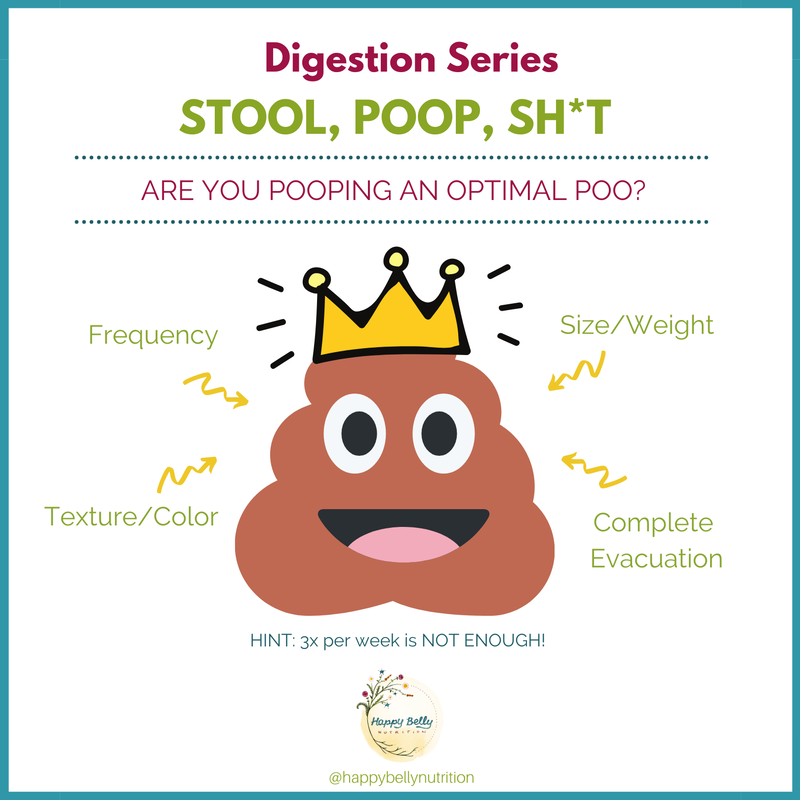|
How many times should we poop a day or a week?? What should a healthy poop look like? This unfortunately can be kind of hard to study because most people don't really think about their poop much nor do they know what is considered normal. So when asked in a survey to describe their bowel frequency and texture, some people may not even really know how to answer these questions. Do you know?? Unfortunately, WE DON'T TALK ABOUT POOP ENOUGH. Granted, it’s not the best table talk (unless of course you’re out to dinner with a group of dietitians), but it is something we all need to be aware of and educated about. A recent study in 2017 studied the US population via a survey asking these exact questions. How often do you poop each week and what does it look like (based on the Bristol stool chart). Here is what they found: 3% have < 3 poops per week 60% have 3-7 poops per week 30% have 8-14 poops per week 6% have 15-21 poops per week 1% have >21 poops per week They also found that normal poops happen more often in men than women, in those with a higher education and income, in those requiring less medications (<2 per day), and in those who eat more fiber (>20g per day). Based on the above results, researchers concluded that normal for the US population is considered at least 3 poops per week up to 3 poops per day. However, this doesn't really highlight the other considerations of what is considered a healthy bowel movement such as the texture of the poop (is it firm, sticky, loose, pebble-like), the stool weight (how big is it), or the sense of complete evacuation (do you feel empty afterwards?). Another study of Coastal Indians, who eat a predominately plant based diet, found that the average stool frequency was 14 poops per week, mostly resembling an easy to pass smooth banana. They also found that vegetarians and more physically active individuals tended to pass stool more frequently. Average stool weight in Asia is also much higher than that of a Western populations, with an average of 311g per 24 hours. Stool weight in many Western populations is low (80-120g per day) which is associated with an increased risk of colon cancer. Stool weights of 150g per day can help reduce this risk.
So what is considered optimal?? Clinically, I do not agree with 3x per week! The Western population as a whole is not eating enough fiber. If you look at other higher fiber eating populations, they average 2 poops per day, with an average poop weight of 150g. This translates to TWO LARGE, firm but not hard, easy to pass, bowel movements per day. I also see this in my clients. When they are pooping 2x per day, they feel good, they look good, and they are happier. So just because you are pooping every day, it does not mean your poop is considered optimal. If you are concerned about your pooping habits, work with a gut health dietitian (like me!)
0 Comments
In healthy individuals after eating a mixed meal, it usually takes about 4-5 hours for that meal to completely empty the stomach and 5-6 hours for that meal to empty the small intestine. This all can vary depending on what you eat and how well your gut muscles are working. Eventually, the remaining unabsorbed food matter (like fiber) and water, move through the ileocecal valve, the doorway from the small intestine to the large intestine. As the unabsorbed matter passes through the ileocecal valve, the large intestine monitors how much undigested material there is. If there are increasing amounts of undigested food, especially fats, it signals to the small intestine to S L O W D O W N. This is called the ileal break and is necessary to help maximize our absorption of nutrients. This mechanism also reduces our appetite. This is why when individuals struggle with diarrhea, they often do not have much appetite. Once the unabsorbed liquid food matter passes through into the large intestine a few things happen:
On average in healthy folks it takes about 30-40 hours for the mass to travel the entire 1.5 meters of the large intestine, going up along your right side (called the ascending colon), across your upper abdomen (called the transverse colon) and back down your left side (called the descending colon). In individuals struggling with idiopathic constipation, their colonic transit time can be greater than 100 hours! When colonic transit time is slowed and stool is stagnant in the colon, it allows chemicals, toxins, and hormones originally bound for elimination, to be reabsorbed into circulation. This can increase your risk of hormonal imbalance and impaired detoxification due to increased stress on the liver and kidneys. Also, slowed transit time can contribute to diverticulosis and colon cancer, as well as the overgrowth of bacteria and fungus in both the small and large intestines. Furthermore, slowed motility usually presents along with hard to pass stools and straining, leading to uncomfortable hemorrhoids. The total amount of time for a meal to be digested and absorbed and the remainder excreted as a bowel movement is called your gastrointestinal transit time (GTT). If your transit time is <12 hours you are likely struggling with nutrient malabsorption, if your transit time is >48 hours then you are likely struggling with constipation. If it takes more than 72 hours for food to travel from mouth to toilet, there is significant backup. I find that around 24 hours is usually the sweet spot for most—what you ate yesterday, leaves you today! Are you curious what your stool transit time is? Generally, if you eat a higher fiber diet, stool transit time should be faster than if you eat a low fiber diet. However, if you eat a high fiber diet and still struggle with constipation something else is going on. This is the perfect time to work with a gut health dietitian for guidance. TESTING YOUR STOOL TRANSIT TIME Although not the gold standard, testing stool transit time at home can give you a rough estimate on your personal window. Sesame seeds remain undigested and pass through the gut intact. White hulled sesame seeds are more easily seen than dark sesame seeds. Alternatively, eat a steamed red beet. THE SESAME SEED (or red beet) CHALLENGE
References: Gastrointestinal Tract: How Long Does it Take? http://www.vivo.colostate.edu/hbooks/pathphys/digestion/basics/transit.html Ileal Brake: neuropeptidergic control of intestinal transit. https://pubmed.ncbi.nlm.nih.gov/16968603/ Physiology, Large Intestine. https://www.ncbi.nlm.nih.gov/books/NBK507857/ Measuring colonic transit time in chronic idiopathic constipation. https://pubmed.ncbi.nlm.nih.gov You WANT a stomach NINJA, not a stomach COUCH POTATO. Once food is swallowed as a bolus, it enters the stomach and stretches the stomach lining, activating stretch receptors and stimulating the parietal cells to make more stomach acid. In fact, the gastric phase is responsible for 60% of stomach acid production whereas the cephalic phase is responsible for about 30%. Continuous activation of the enteric nervous system (which can be influenced by the parasympathetic and sympathetic nervous systems) also stimulates the release of gastrin causing an increase in strong and vigorous muscle contractions, and pepsinogen from chief cells. Pepsinogen, in the presence of adequate amounts of stomach acid, is then activated to pepsin, a protein digesting enzyme. As your stomach churns your food and mixes it with stomach acid and digestive juices, it also starts the process of B12 digestion and absorption. Stomach acid separates B12 from animal proteins so that B12 can bind to another protein called intrinsic factor which is only produced in the stomach. This process is essential in order to absorb B12 from our food. Plus, it can also kill potentially harmful bacteria, viruses, and parasites, coming in through your food. So now your stomach is not just a powerful blender…it is a mean blender NINJA. After foods have been properly broken down, the stomach gradually releases the stomach contents (now called chyme) into the upper small intestine. However, if you have a higher fat or higher fiber meal, stomach emptying is slowed, and can contribute to longer feelings of fullness, than if you had a low fat processed meal, like cereal. Common symptoms of low stomach acid:
I see many of the aforementioned symptoms in my practice all the time. There are many reason why someone might have low stomach acid, and sometimes there is more than one variable involved. Below I have highlighted those that I see most often.
Okay, now you likely want to know, “Do I have low stomach acid?” If you experience chronic digestive issues and any of the symptoms mentioned above, then the answer is likely yes. Once you address your stomach acid production, then you can help improve many things downstream on the river of gut health. Therefore, it is essential to address this first! How do you Test for Low Stomach Acid? The gold standard is a Heidelberg Stomach Acid Test and can get expensive, averaging around $350. Unfortunately, many GI doctors do not run this test, even when patients ask for it. If you want an alternative to this, then check out the simple at home test below to see if you struggle with low stomach acid. Baking Soda Challenge Although this test is not supported by any studies, it can be a simple and cheap way to check your stomach acid production. All you need is a fresh container of baking soda and water.
If your results suggest LOW stomach acid, then it’s time to figure out WHY and work with a gut expert. If you want my help and guidance, then make your discovery call today! References: http://www.vivo.colostate.edu/hbooks/pathphys/digestion/stomach/onemeal.html https://www.ncbi.nlm.nih.gov/books/NBK499926/ https://pubmed.ncbi.nlm.nih.gov/15184707/ https://www.ncbi.nlm.nih.gov/pmc/articles/PMC3460328/ https://pubmed.ncbi.nlm.nih.gov/20581234/ https://www.ncbi.nlm.nih.gov/pmc/articles/PMC5076771/ https://www.ncbi.nlm.nih.gov/pmc/articles/PMC3144339/ https://pubmed.ncbi.nlm.nih.gov/1494327/ https://www.cambridge.org/core/journals/proceedings-of-the-nutrition-society/article/ageing-and-the-gut/A85D096755F5F7652C262495ABF302A0 https://pubmed.ncbi.nlm.nih.gov/8612992/ https://www.ncbi.nlm.nih.gov/pmc/articles/PMC6354172/ https://pubmed.ncbi.nlm.nih.gov/2690329/ https://pubmed.ncbi.nlm.nih.gov/2858363/ |
AuthorLike to read? Then get your evidence based nutrition information here! All posts written by Selva Wohlgemuth, MS, RDN Functional Nutritionist & Clinical Dietitian Archives
August 2023
Categories
All
|
Providing custom functional nutrition therapy since 2015.
Follow HBN on Social Media!
©Happy Belly Nutrition, LLC 2015-2023
Proudly powered by Weebly







 RSS Feed
RSS Feed


